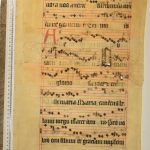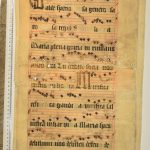According to the bibliographical description, the maculature includes a “muniment catalogue of 16 items 1644–1646, imperial and provincial, for locally (Breslau) relevant political and military documents from the Thirty Years War.”
On the recto of the fragment the troped Alleluia O gloriosa mater Christi was preserved. This chant fits into the late medieval melodic style named – after Martin Schildbach – as the “liedhafte-E-Melodik”. This style became popular in the Central European region in the 14 th–15th centuries, primarily in Alleluias and chants of the Mass Ordinary (eg. Alleluia O Maria rubens rosa). The distinctive frigian melodiousness and its specified tools, as well as the enhancement of the main notes from the modal frame or the use of certain intervals and melodic phrases is so immensely uniform, that in some cases this uniformity makes it difficult to decide which pieces can be regarded as a traditional contrafact, and which are the manifestations of the relation derived from the usage of a mutual musical language. About this late medieval melodic style see: Gábor Kiss, “The »liedhafte E-Melodik«”, in Studia Musicologica Academiae Scientiarum Hungaricae 40 (1999/4), 315–324.
Zsuzsa Czagány



